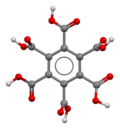 | |||
| |||
| Names | |||
|---|---|---|---|
| Preferred IUPAC name Benzenehexacarboxylic acid | |||
| Other names Graphitic acid | |||
| Identifiers | |||
3D model (JSmol) | |||
| ChEBI | |||
| ChEMBL | |||
| ChemSpider | |||
| DrugBank | |||
| ECHA InfoCard | 100.007.495 | ||
PubChem CID | |||
| UNII | |||
CompTox Dashboard (EPA) | |||
| |||
| |||
| Properties | |||
| C12H6O12 | |||
| Molar mass | 342.16 g/mol | ||
| Density | 1.68 g/cm3, 2.078 (calc.) [3] | ||
| Melting point | >300 °C (572 °F; 573 K) | ||
| Boiling point | 678 °C (1,252 °F; 951 K) (calc.) [3] | ||
| Acidity (pKa) | 1.40, 2.19, 3.31, 4.78, 5.89, 6.96 [4] | ||
Except where otherwise noted, data are given for materials in their standard state (at 25 °C [77 °F], 100 kPa). | |||
Mellitic acid, also called graphitic acid or benzenehexacarboxylic acid, is an acid first discovered in 1799 by Martin Heinrich Klaproth in the mineral mellite (honeystone), which is the aluminium salt of the acid. [5] It crystallizes in fine silky needles and is soluble in water and alcohol.


